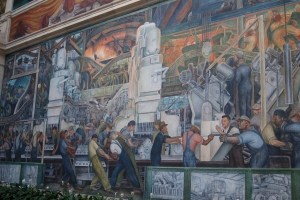|
Displaying items by tag: storage
Bankruptcy Judge Steven Rhodes ruled Thursday that he won't allow some of Detroit's largest creditors to remove art from the walls at the Detroit Institute of Arts in order to inspect and appraise the art as part of the city's bankruptcy.
The creditors had argued that doing so would let their outside experts help determine the artworks' value.
Rhodes also denied the creditors' motion seeking access to up to a million additional pages of historic documents about the art housed at the city-owned museum. However, Rhodes said he would allow creditors to work with DIA officials to allow access to artwork in storage at the museum.
The American Folk Art Museum announced that it will open an annex for its collection and library in Long Island City, Queens, near the LaGuardia Performing Arts Center. The 17,000-square-foot facility, which is expected to open early next year, will provide the museum with extra space for storage and exhibitions.
In 2001, the Folk Art Museum opened its monumental Tod Williams and Billie Tsien-designed building on West 53rd Street in Manhattan. The museum soon fell into financial turmoil and in 2011, was forced to sell the building to the Museum of Modern Art and move to a smaller location in Lincoln Square. The Museum of Modern Art has since decided to raze the Folk Art Museum’s former home to make way for an upcoming expansion.
Founded in 1961, the American Folk Art Museum is devoted to traditional folk art and contemporary self-taught artists. Its collection includes over 5,000 objects from the 18th century to the present.

The Joslyn Art Museum in Omaha, Nebraska, announced that a painting that had been relegated to storage for a decade has been authenticated as a work by Rembrandt. The canvas, which has been in the museum’s collection for 72 years, was previously attributed to “The Circle of Rembrandt.” A recent reassessment by Rembrandt expert Ernst van de Wetering proved that the painting was made by the Dutch master himself.
“Portrait of Dirck van Os” was purchased by the Joslyn Art Museum in 1942 from a private collection as an authentic Rembrandt. A later assessment saw the painting reclassified as a work by one of Rembrandt’s students. After a visit to the Joslyn Art Museum in 2010, Van de Wetering had the work sent to Amsterdam for restoration. After later additions of paint were removed, a very different portrait was revealed, leading the scholar to deem the work a late painting by Rembrandt.
There are approximately 300 Rembrandts known to exist. “Portrait of Dirck van Os” will go on view at the Joslyn Art Museum in May.

The Walters Art Museum in Baltimore, Maryland, announced that it will renovate its Hackerman House, one of five buildings on the institution’s campus. The 19th-century mansion, which houses the Walters’ Asian art collection, will close on July 1 so that its fire safety and mechanical systems can be updated. In addition, the building’s galleries will be refurbished and the exterior will be repaired. The project is expected to take approximately 18 months to complete.
Art normally displayed in the Hackerman House’s galleries will mostly be moved to storage during the renovations while a select few pieces will go on view in other areas of the museum. In addition to some private fundraising, the $5.2 million project is being financed by the city and state.
Founded by William Thompson Walters and his son, Henry Walters, the Walters Art Museum is renowned for its Egyptian, Greek, Roman, Byzantine, Ethiopian, and Western medieval art collections as well as its holdings of Renaissance and Asian art. The Walters also has an impressive collection of illuminated manuscripts and rare books.
The Metropolitan Museum of Art announced that it will rename its famed Costume Institute for Anna Wintour, the Editor in Chief of ‘Vogue’ and Conde Nast’s Artistic Director. Wintour has been a trustee of the museum since 1999 and has raised approximately $125 million for the Costume Institute alone. In addition, she helped collect enough funds to facilitate the Institute’s two-year renovation, which cost approximately $40 million.
The Anna Wintour Costume Center will open on May 8 and will include a renovated 4,200-square-foot main gallery, an updated costume conservation lab, and expanded study and storage facilities.
AXA Art Insurance Co. has leveled a lawsuit against Christie’s over several paintings that were destroyed last October during Hurricane Sandy. The claim states that the auction house failed to secure a valuable art collection that was being kept in one of its storage facilities in Brooklyn, New York despite the ongoing warnings about the damage Hurricane Sandy was expected to bring.
Paintings worth at least $1.5 million, which once belonged to the late cellist Gregor Piatigorsky and his chess champion wife, Jacqueline, were left on the ground floor of the storage facility where they were damaged by rising flood waters. While the suit didn’t specify which works were destroyed, the Piatigorskys’ collection included paintings by Edgar Degas, Claude Monet and Chaim Soutine.
A rep for Christie’s told the New York Daily News that they have not yet been served with court papers.

Thanks to a grant from Bank of America’s Art Conservation Project, the Detroit Institute of Arts has embarked on a research endeavor focused on examining and digitally photographing 13 full-scale preparatory drawings by Diego Rivera for his Detroit Industry murals. The drawings have not been viewed since 1986 and have never been photographed. The project, which started on July 22, 2013, will last through August 2, 2013 and will include any necessary conservation work on the drawings.
Rivera gave the drawings, which are housed in a climate-controlled custom storage in the museum, to the DIA after he completed his monumental Detroit Industry murals in 1933. The series of frescoes, which features 27 panels surrounding the museum’s Rivera Court, depict the then state-of-the-art Ford Motor Company River Rouge Plant. The murals stirred up controversy following their completion and critics deemed the works blasphemous, vulgar, un-American and Marxist propaganda. While members of the Detroit community called for the destruction of the murals, commissioner Edsel Ford and DIA Director Wilhelm Valentiner defended the murals’ right to exist.
Following the research project, 5 of the 13 panels will be go on view at DIA as part of an exhibition of works by Rivera and his wife Frida Kahlo created during their time in Detroit.

Washington, D.C.’s Smithsonian Institution, which is comprised of 19 museums and 9 research centers devoted to the “increase and diffusion of knowledge,” has seen an rise in troubles relating to their storage system. The Smithsonian currently has 130 million objects ranging from paintings and furniture to skeletons in their storage and maintenance facilities, many of which reside in damaged containers or poorly organized archives. During a recent audit, the National Museum of American History was allegedly unable to locate 10% of their collection.
The Committee on House Administration held a hearing on Wednesday, July 17th to discuss the challenges facing the care of the Smithsonian’s collections of art, archival footage and delicate objects. Smithsonian Inspector, General Scott Dahl, claimed that the institution is still employing poor storage space that was built in the 1950s and never intended for long-term use. A report from the Smithsonian’s inspector general in 2006 showed that not only were the storage facilities inadequate, but that security and inventory controls were lacking, leaving some of the country’s most precious treasures susceptible to theft or misplacement.
The Smithsonian has been working to fix their storage and maintenance issues for the past seven years and has invested $462 million in collections management and $390 million in facilities improvements. However, ongoing budget cuts have made fixing these issues once and for all, increasingly difficult. In addition, a large portion of the Smithsonian’s budget is currently being used to digitize the museum’s collection, which could take years.

Back in December 2012, officials at the New York Public Library released a number of important details pertaining to their $300 million renovation. Part of the project involved clearing out the back portion of the library, which is housed in a landmark building on Fifth Avenue in Manhattan.
The plan has 1.2 million volumes being relocated to a storage space under Bryant Park as well as another facility in Princeton, NJ. Most of the exiled books are now available digitally and library officials purposely chose rarely requested books to be relocated. With the newly freed up space, the architecture firm Foster & Partners, plan to create a four-level atrium with curving balconies filled with bookshelves and reading tables overlooking Bryant Park. It will be the first time since the library was built in 1911 that patrons will be able to see the park.
The library received a fair amount of criticism after announcing their plans to renovate and Advocates for Justice, a nonprofit organization, has just filed a lawsuit on behalf of five preservations and scholars. The plaintiffs are arguing that the library is violating its charter and the state’s constitution by removing the aforementioned books. The suit also claims that the library failed to conduct an environmental impact review for the renovation plans. While the library recently applied for building permits, officials claim that they are for “preliminary work” and that the designs have not been finalized.
The busiest public research library in the United States, the New York Public Library is expected to span 100,000 square feet after renovations are complete. Construction is slated to begin this summer and is expected to last until 2018.

In February, the Fred L. Emerson Foundation and the Seward House Museum in Auburn, New York announced that they would sell a significant painting by the English-born American artist and founder of the Hudson River School, Thomas Cole (1801-1848). The sale of the work, titled Portage Falls on the Genesee (1839) is intended to benefit the institution, which opened to the public in 1955 and became a registered National Historic Landmark in 1964.
Portage Falls was given to the American politician William H. Seward while he was the governor of New York prior to the Civil War. Seward went on to serve as Secretary of State under Abraham Lincoln and Andrew Johnson and after his death his home and its contents were donated to the Fred L. Emerson Foundation. The Foundation opened the Seward Museum but it became a fully independent, not-for-profit institution in 2009; the Cole painting was retained by the foundation.
The work, which depicts what is now Letchworth State Park in western New York, has been on view at the Seward Museum for 170 years and not everyone is pleased with the Foundation’s decision to sell it. A group known as the Seward Legacy Preservation has formed and will hold their first meeting at the Auburn Public Theater in Auburn, New York on Monday, April 29, 2013. Members of the organization, which include descendants of Seward, will fight to restore the painting to its former place in the Seward House. The painting is currently being kept in a secure storage location.
Portage Falls is said to be worth millions of dollars, which the Foundation and the Seward Museum plan on splitting when the painting sells.
|
|
|
|
|